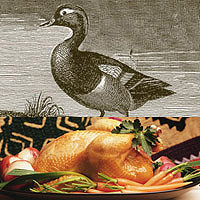Penn Herb Wellness Guide
Duck

Preparation, Uses, & Tips
Check for any feathers and remove from skin. Wash duck thoroughly in cold water and pat dry with paper towel. Duck should always be cooked until well done. For best results, use a meat thermometer inserted in the meatiest part of the duck. Duck is done when internal temperatures read a minimum of 165F (74C). To test for doneness without a thermometer, make sure a fork can be easily inserted, and that when the meat is pricked, juices run clear (not pink).
Roasting
Thoroughly prick the duck’s skin without piercing the flesh. Place duck on a rack in a shallow pan, breast side up. Pour a small amount of water or stock in the pan, and check occasionally during the roasting time. Place duck in an oven preheated to 450F (230 C) for 5 minutes and then lower the temperature to 350F (180C). Occasionally baste with pan liquids. If parts of the bird become too brown, shield them with foil. Roast for 20 minutes per pound (454g), or until internal temperature reaches at least 165F (74C). Let stand 15 minutes before carving.
Braising
Cut mature duck in pieces and trim off excess fat. Heat a skillet over a medium burner until hot. Add oil, and brown both sides of duck pieces at moderately high heat. Drain fat, add cooking liquid (water, wine, or broth with herbs, spices, and vegetables if desired), cover pan, and place in preheated 350F (180C) oven for one hour.
Broiling
Preheat broiler. Line broiler pan with foil for easy cleanup. Spray rack of broiler pan with nonstick cooking spray, if desired. Place duck halves, leg quarters, parts, or boneless, skinless duck pieces on rack set in broiler pan. Position oven rack so that duck pieces on broiler rack are 6 inches (15cm) from the heat source. To prevent released fat from smoking, check pan every two minutes and sprinkle salt directly on any fat in the bottom of the pan. Broil, turning over several times, until duck is golden, juices run clear, and internal temperatures reach at least 165F (74C). Boneless duck takes approximately four to five minutes per side; bone-in pieces, depending on the size, take about 20 minutes per side. Use tongs to turn over duck to prevent piercing the flesh and loss of juices during cooking.
Copyright 2025 TraceGains, Inc. All rights reserved.
Learn more about TraceGains, the company.
The information presented in the Food Guide is for informational purposes only and was created by a team of USregistered dietitians and food experts. Consult your doctor, practitioner, and/or pharmacist for any health problem and before using any supplements, making dietary changes, or before making any changes in prescribed medications. Information expires December 2025.


